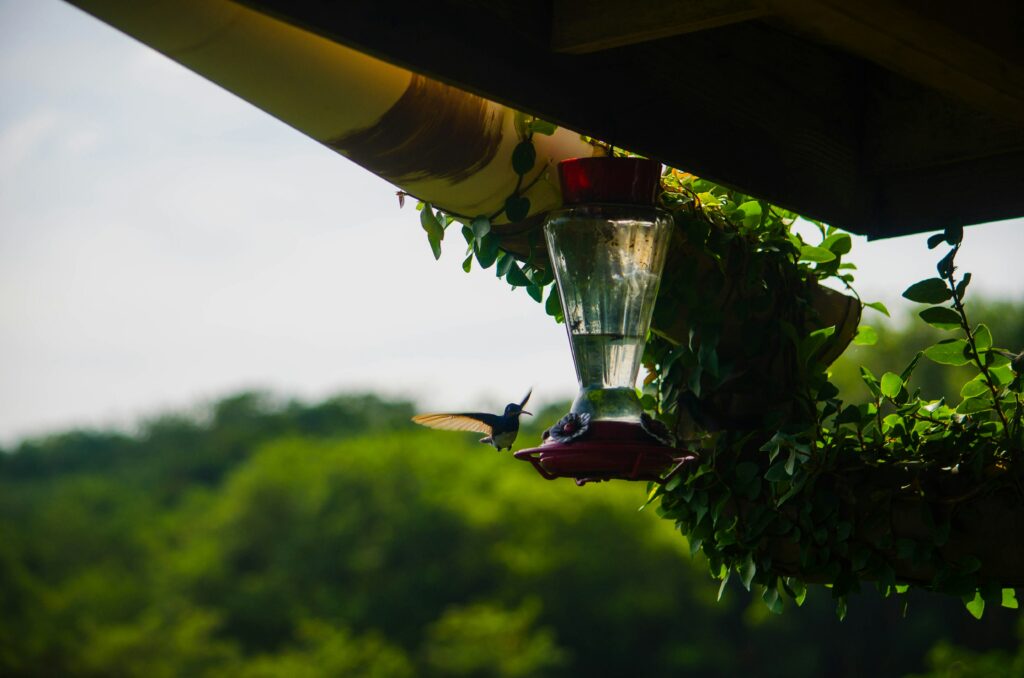This month we are launching our new project: Stories of Hope. Inspired by the #IAmAnImmigrant project by I Stand With Immigrants, we hope to share the stories of our amazing clients and their journeys coming to the United States. Our hope is to share the stories and faces behind the complexity of immigration in the US today. With the goal to go beyond politics and soundbites, we want to share the stories of immigrants in our community. Today we will kick off this project with Rachel’s story, a client from Trinidad and Tobago.
Trinidad and Tobago
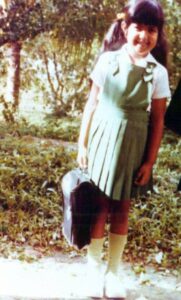 The country has a long and diverse history, being British-ruled until 1969. Rachel herself is of Indian descent, saying that she “grew up pretty much according to Indo or Indian standards because my ancestors were indentured laborers that were brought over from India to Trinidad.” The island is also very diverse, having a mixed population; “It’s mostly half Africans half Indians. So we grew up in a very diverse population” with “visitors and people coming into the island.” However, this diversity presented some challenges for Rachel’s culture and identity. She reflects, saying “We were very westernized and that even though we were traditional Indian, you weren’t expected to wear the clothes, but then you had [access to American] media.”
The country has a long and diverse history, being British-ruled until 1969. Rachel herself is of Indian descent, saying that she “grew up pretty much according to Indo or Indian standards because my ancestors were indentured laborers that were brought over from India to Trinidad.” The island is also very diverse, having a mixed population; “It’s mostly half Africans half Indians. So we grew up in a very diverse population” with “visitors and people coming into the island.” However, this diversity presented some challenges for Rachel’s culture and identity. She reflects, saying “We were very westernized and that even though we were traditional Indian, you weren’t expected to wear the clothes, but then you had [access to American] media.”
Growing up in the 80s, Western media and culture were prominent in her childhood. With networks like MTV, Rachel had a window into the all-American life, but then, “You’re living on this little island where nothing happens, you know, and nobody comes to give a concert.” As a teenager, she saw a life that she could only dream of getting. Even so, Rachel reflects on how “it was a healthy life. I would say we ate great food.” She spent time with her friends, going to beaches and enjoying the island.
Culturally and politically, the island “has always been divided by race,” Rachel says. “So growing up, there was a lot of tension among Africans and Indians, and there still is today.” With the island’s history of British rule, there was a heavy British influence in the local traditions and culture; “even down to the words we say biscuits [and] we drink tea. It’s just the influence.” In her own life, Rachel states how she was heavily influenced by the Commonwealth and Indian cultures.
Childhood & Family
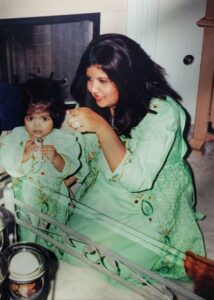 Rachel grew up with a Hindu father who later converted to Christianity. As a result, he was thrown out of his house at the age of thirteen. Rachel’s mother was Muslim, although not practicing. Because of this, she grew up learning about all religions around her. Her childhood was filled with religious diversity by attending a Hindu elementary school, going to church on Sundays, and learning about Muslim traditions from her friends. All of these different cultures and traditions seeped into her life.
Rachel grew up with a Hindu father who later converted to Christianity. As a result, he was thrown out of his house at the age of thirteen. Rachel’s mother was Muslim, although not practicing. Because of this, she grew up learning about all religions around her. Her childhood was filled with religious diversity by attending a Hindu elementary school, going to church on Sundays, and learning about Muslim traditions from her friends. All of these different cultures and traditions seeped into her life.
“Growing up, having that exposure to every single book in the country, like we went to churches, we went to Hindu prayers. We went to masjids and mosques and did prayers with them. We had friends and neighbors, and everyone was just very, very diverse religiously.” This is why “I can’t make a decision on one religion because I see the commonality across all three,” Rachel says, describing her diverse upbringing. After marrying, Rachel converted to Islam, “and observed Ramadan and prayer times out of respect for my then-husband’s family.” She never felt the pressure of having to choose one or the other; “I always had the choice to pick a religion but felt that they all carry the same philosophy of doing good over evil. To me choosing one religion means you’re choosing which ‘stories’ you believe in vs the overall message.”
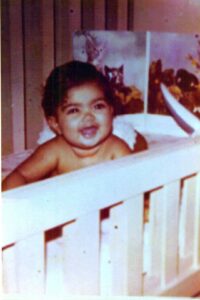 As a child, Rachel was always drawn to American culture. She’d see things like “Casey Kasem’s Top 10, MTV, clothes, music and, you know, everything that was cool was American. Right?” She also saw how the island was becoming more competitive academically and in the job market. Coming out of the 70s with an oil boom and lots of money, it started to taper off in the 80s. Suddenly everyone needed more and more education to be able to get a job; eventually, it got to the point where “the dude with the Master’s is the one taking the job that I’m supposed to get.” Entry-level jobs were given to people with multiple university degrees and Rachel was only fresh out of high school. If she couldn’t find a job, her path would be that of a traditional Indian family: “If you cannot afford to send all your children to [university], you send the eldest, which was my sister.”
As a child, Rachel was always drawn to American culture. She’d see things like “Casey Kasem’s Top 10, MTV, clothes, music and, you know, everything that was cool was American. Right?” She also saw how the island was becoming more competitive academically and in the job market. Coming out of the 70s with an oil boom and lots of money, it started to taper off in the 80s. Suddenly everyone needed more and more education to be able to get a job; eventually, it got to the point where “the dude with the Master’s is the one taking the job that I’m supposed to get.” Entry-level jobs were given to people with multiple university degrees and Rachel was only fresh out of high school. If she couldn’t find a job, her path would be that of a traditional Indian family: “If you cannot afford to send all your children to [university], you send the eldest, which was my sister.”
Rachel saw her future if she stayed in Trinidad and Tobago: “working in my mother’s company and relying on [my parents] for the rest of my life.” But Rachel knew that was not the life she wanted or the life her parents wanted for her. Instead, she “wanted to be in a country where there was opportunity. There was room for advancement. There was intellectual growth. I wanted to have that chance and that’s why I left.”
Coming to the United States
At 19, Rachel got married and started working hard at her job to raise the funds for a plane ticket. With 200 American dollars and some clothes, she arrived in the US. There, she stayed with family. Later, she met up with her husband and stayed with his family in New York.
Although she would have loved for her parents to join her, they decided to remain in Trinidad and Tobago. They had built a home on the island and wanted to remain in the place they knew. Even now that Rachel is a US citizen and could sponsor her mother to join her, she remains adamant to stay on the island.
Leaving the island and everything she knew behind meant that she no longer had her support system close by. When asked what she misses about her home country, Rachel immediately said her friends—and the food. It was hard to stay in touch with family and friends at the time with the cost of international phone calls and plane tickets. But even so, Rachel describes the main feeling as excited for her future when she left for the US. “I felt like I was going to a place where I don’t know where I’ll be in the future. I didn’t know what was in front of me, but I was determined to make it work. I was just really excited to be out in the world in America where I always wanted to be.”
Life in the United States
 Coming to the US felt like a dream to Rachel. Reminiscing, she states, “Sometimes I drive up to my house and I look at it and I think, is this really happening? Do I really live here?” In her actual dreams, she is sometimes back in her home country, but as a nightmare; “I dream that I’m stuck there and I don’t have this life anymore.”
Coming to the US felt like a dream to Rachel. Reminiscing, she states, “Sometimes I drive up to my house and I look at it and I think, is this really happening? Do I really live here?” In her actual dreams, she is sometimes back in her home country, but as a nightmare; “I dream that I’m stuck there and I don’t have this life anymore.”
Everything changed for Rachel when she came to the US. “Being able to afford my bills, being able to afford to have a kid.” When she became a mother, her perspective changed even more; “I wanted to do more for her and make sure that she got everything.” Being in the US, she was able to make sure her daughter could go to university, which was not always an option for Rachel in her country.
In the US, doors opened for Rachel that she did not have before. “I feel accomplished. I have a great job with a company that supports me. I’ve been promoted several times. I can travel wherever I want. I have enough disposable income. I’m looking at buying a beachfront property this weekend. You know, my life has changed from where it was when I first landed with $200 a month in my pocket.”
Calling America Home
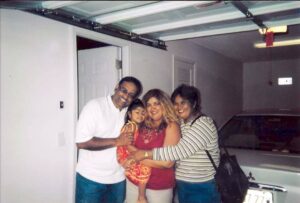 The first time Rachel felt truly at home in the United States was when she bought her first home after having her daughter at the age of 27. “We were living in New York City, renting a studio apartment, and we had no room.” Her then-husband’s family told them “Hey, well, why don’t you move down to Georgia—that way you have family here to help with.” Her daughter was the first grandchild on both sides, so they knew having family around would be good.
The first time Rachel felt truly at home in the United States was when she bought her first home after having her daughter at the age of 27. “We were living in New York City, renting a studio apartment, and we had no room.” Her then-husband’s family told them “Hey, well, why don’t you move down to Georgia—that way you have family here to help with.” Her daughter was the first grandchild on both sides, so they knew having family around would be good.
Although they didn’t think they would be able to, they got a loan and bought a house. “I watched this thing being built from the ground up and it truly felt like my home because I picked out everything….I bought the furniture. I settled there for several years. I mean, I felt like it was home. It was mine. It was the first thing I’ve ever [owned] in my life to say that it was home.”
Reflecting on her identity now, “When I think of America as home, I moved here at such a young age that I’ve disconnected with Trinidad and I’m more American than I am Trinidadian. I don’t want to be anywhere else in the world.”
Community and Immigrants
 With so much anti-immigrant rhetoric in the media, it is hard to bridge that divide between locals and newcomers. Each side has particular perceptions and biases of the other; one of the reasons we have launched this series—to tell the stories about those in our communities. However, there are many ways that communities can come together and learn about each other’s backgrounds. When asked what she wishes the community would know about her and immigrants in general, Rachel had a lot to share.
With so much anti-immigrant rhetoric in the media, it is hard to bridge that divide between locals and newcomers. Each side has particular perceptions and biases of the other; one of the reasons we have launched this series—to tell the stories about those in our communities. However, there are many ways that communities can come together and learn about each other’s backgrounds. When asked what she wishes the community would know about her and immigrants in general, Rachel had a lot to share.
“There is a lot of awareness now — people who want to learn and be more open-minded and want to learn about their neighbors in their community. They have the resources to do that. They can do that if they wanted to.”
When it comes to religion and personal beliefs, Rachel states, “I wish people would understand that you can be Muslim without being traditional. You can be a religion without being a fanatic — a believer of many things without being siloed into one sort of restrictive book. And I think religion for me has always been that sort of sore point because people you meet…they’re either accepting or they’re not, and they’re either very religious or they’re not.
“I think for the community, we all just [need to] take the time to sit down and ask each other questions and not be so offended by everything that everyone asks you. Because you and I are different. I only know what I’ve [experienced] and maybe I have a bias, but if we don’t communicate, you can’t bridge that gap. So I wish people would see me and think it’s okay to ask me a question. I’m open to it. I’m not going to judge someone or, you know, look down on them or be offended because they don’t know.”


